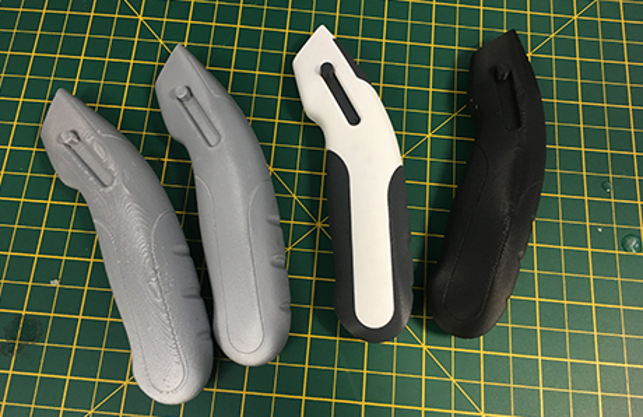The desktop 3D printing hype has now settled into a set of useful and robust tools for the professional user. Al Dean takes a look at how far we’ve come, how the tools stack up and gives some thoughts on how you make a choice

Same part from the Ultimaker 3 Extended (first two at 0.4mm, 0.06mm and multimaterial) then the Markforged Onyx One (right)
Three years ago the 3D design and engineering technology market was going nuts over the rise of desktop 3D printing. Every week we saw a new machine, a new process and another Kickstarter launch.
All of the talk was about how this was going to revolutionise the manufacturing industry and how we’d all be producing spare parts at home.
Fast forward to today and we’ve got a very different market. There are now much more measured claims about the future and this is clearly split into two categories — 3D printing on the desktop and Additive Manufacturing at the industrial end of the spectrum.
In the last few months, we’ve been focussed squarely on the former. After all, the biggest potential for 3D printing at the desktop level is the ability for the design and engineering community to have these tools in-house.
Over these few months, we’ve spent quality time with the new Maketbot Replicator+, the Formlabs Form 2, the Markforged Onyx One and the Ultimaker 3 Extended. I’ve learned a great deal about how this market is evolving and thought I’d share some thoughts.
The first is that I don’t envy anyone that has a budget of, say four grand, to spend on a desktop machine. The choices available are widespread, but there’s also a lot of variation within that choice.
Your selection of which machine you want ranges from either having a very specific task in mind or a challenge to solve, or a desire for a more flexible solution to the problems you have in your workflow.
The reality is that all of the machines we’ve tested have been reliable. Failed builds have been minimal and when they have failed, it’s typically down to user error, rather than a problem with the machine.
The issue of platform level and machine calibration has, in these machines at least, been solved to a lesser or greater extent.
Either the machines are reliable and not prone to variation from your initial or regular levelling (something that’s very much the case with the Markforged machines) or this is handled automatically (something that’s key to both the Ultimaker and the Makerbot machines).
Speed is also improving, but there are always limits on how fast you can cure resin or melt polymer filament. The software side of things is also getting more robust, particularly when combined with more intelligent hardware.
A good example of this is the automatic recognition of material feed in both the Form 2, the Replicator+ and the Ultimaker machines. When you load your new material, the machine knows what it is, tells your set-up software and away you go.
Another interesting capability is great onboard processing and queue management — something that both the Markforged and the Formlabs machines excel at.
These allow remote access to your machine (or multiples) and enable the user (or, indeed, users) to queue up jobs, and then choose them from the machine interface.
Markforged’s project-led approach builds on this to take things to the next level.
Then you’ve got materials. This is perhaps where the future action is going to be — allowing more interesting and intelligent material choices to be made. Or, indeed, strip them back to the bare minimum to make them truly excel. Good examples of this are the Ultimaker and the Formlabs machines. These have a wide range of materials and each has its own capabilities, strengths and, of course, weaknesses.
At the opposite end of the spectrum is Markforged Onyx One. This builds one material, a nylon with carbon nano-particle based filament, and does it supremely well.
Ultimately, your choice of machine comes down to what you want to do with that machine. For example, if your need is for robust parts in a range of polymers, then the Ultimaker is a good choice, with dissolvable supports. The Formlabs machine excels at high resolution parts in a range of materials. If you’re looking for strong, stiff parts (perhaps for jigs and fixtures or low volume end use parts), then the Markforged is a good solid choice.
But, of course, the choice is yours. The benefit is that whatever you choose, you’re now getting more sophisticated, intelligent machines at a much lower cost — and that’s only going to become increasingly the case as we progress.
Having reviewed a few recently, we give some thoughts on how to make a choice
Default






